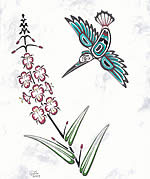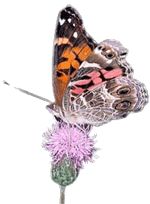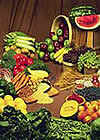 |
Cultural Importance of Pollination

A hummingbird flits among the blossoms of a fireweed. This original design was done in the style of, and greatly influenced by, the delicate form, lines, and art of the Tsimshian and Tlingit peoples of southeast Alaska. Photo courtesy of Julie Thompson, Featherlady Studio.

Native Peoples traditionally recognized the importance of pollinators:
- Cultural symbolism
- Food plants
- Medicinal plants
- Plant-based dyes
We explore only a few examples of culturally important pollinators or pollinated plants here. To learn more about culturally important plants and pollinators:
Cultural Symbolism
Butterflies
- Raven’s spokesperson - Haida (Pacific NW)
- Messenger (in dreams) from Great Spirit - Blackfoot
- Earth’s fertility - Hopi “Bulitikibi” harvest dance
- Flame, Teotihuacan (Palace of the Butterfly) - Ancient Mexicans (Olmecs, Toltecs, later Aztecs)
- Ancestor - Sumatra, Naga (Madagascar), Pima (N. America)
- Related to Morning Star - Arapaho, Mexecal
Moths
- ‘Tun tawu = “goes in and out of fire” - Cherokee (North America)
- Symbol of knowledge, guardians of gold dust of eternity - Yaqui (Mexico)
- Powder - insanity (moth-crazy, sexual excess, incest, aphrodisiac) - Navajo (North America)
- Guardian of tobacco (caterpillar of Sphinx moth) – Navajo (North America)
Hummingbirds
- Basket weaving teacher - Taroscan (Mexico)
- Courier of gifts to Great Mother - Pueblo Indian Tribe
- Convinced gods to bring rain – Hopi and Zuni Indian Tribes
- Sun in disguise (courting the moon) - Maya
Food and Natural Products
Fun Fact
Corn is mostly a wind-pollinated crop. Native peoples were the first to recognize the role of pollination and to plant corn in such a way that they could hybridize certain types of corn for particular characteristics and purposes. Native Americans are known as the “first hybridizers” for their scientific talents in cross-pollination and hybridization.
Plant domestication began almost 10,000 years ago in Mesopotamia. Approximately 7,000 plant species have been collected and cultivated for human use throughout history. Today 1,000 of the 1,330 plants grown for food, beverages, fibers, condiments, species, and medicines depend on pollinators to help them reproduce and develop healthy, viable seeds and fruits.
American Indians were very adept at breeding maize plants even before sex in plants was firmly established by Camerarius in 1694. The Assyrians and Babylonians artificially pollinated date palms as early as 700 BC.
- Chicle – Aztec Indians used latex from the sapodilla tree in North America. Later they taught New England colonists to chew spruce sap, the first commercially sold chewing gum.
- Latex – The Omec, “rubber people”, made balls and rubber bulb syringes from latex. Mesoamerindians waterproofed clothing and soles of sandals. Now, petroleum rubber has replaced the plant-based form, but harvest of rubber used to drive Amazonian economies.
- Honey enjoys a mystical reputation around the world. Colonists introduced honey to North America in the 1600s. Some accounts say that Native Americans referred to the honeybee as the “white man’s fly” because it followed the settlements across the continent.
- In the middle ages, honey was believed to promote the birth of a male child, which was considered lucky as a first-born. On their wedding day, the father of the groom would give the couple enough honey to last a month (a moon), assuring that the child conceived during the first days of marriage was a boy - HONEY MOON!
- Mead, said to be the oldest fermented beverage, is made from honey. Some histories assert that Greeks, Romans, Egyptians, Ethiopians, Scandinavians, Assyrian, Incas, and Aztec used mead, both in festivals and as a religious drink. They believed it imbues the drinker with attributes such as life, wisdom, courage, and strength.
More Fun Facts
- More than half of the world’s diet of fats and oils come from animal-pollinated plants (oil palm, canola, sunflowers, etc.).
- More than 150 food crops in the U.S. depend on pollinators, including almost all fruit and grain crops.
- The USDA estimated that crops dependent on pollination are worth more than $10 billion per year.
Medicinal Plants
The list of plants below is only a brief sample of entomophilious (insect pollinated) plants of medicinal value.
- Milkweed – tea after childbirth (Navajo)
- Black raspberry – Dysentery (Pawnee, Omaha, Dakota)
- Horsemint – back pain, fever (Catawba)
- Tobacco – medicine/purifier (Many)
- Sage
- Smudging purification (Many native groups)
- Dandelion – tonic, heartburns (Pillager Ojibwas, Mohegan)
- Witch hazel – muscle ache (Menominee)
- Purple coneflower – insect stings & bites (Plains)
- Goldenseal – insect repellent, digestion, respiratory, urinary (Cherokee & others)
Plant-Based Dyes
The list of plants below is only a brief sample of entomophilis (insect pollinated) plants used to make dyes.
- Blues – larkspur, alfalfa flowers, sunflower seeds
- Greens – lily of the valley leaves, juniper berries
- Purples – blueberries, raspberries, blackberries
- Reds – beets, cranberries
- Yellows – goldenrod, sunflowers, marigolds
|



